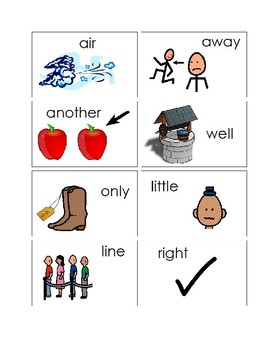100 First Grade Picture Sight Word Flash Cards
Suddenly Tele-SLP
330 Followers
Grade Levels
K - 3rd
Resource Type
Formats Included
- Word Document File
Pages
13 pages
Suddenly Tele-SLP
330 Followers
Description
This product is an addition to my free Kindergarten Sight Word product and the Kindergarten/First grade sight word list. At my school several years ago, we used the Literacy First program. While we no longer use it, I still find their list of sight words very helpful. They were divided into Lists A, B, and C. My Kindergarten/First grade sight word product is essentially List A. This is list B and we used it specifically for first grade, but it applies to advanced kindergartners and delayed 2nd graders. I loved these lists, but they were just words. I have added pictures for context to add meaning to sight word practice. Please read the description below to understand the purpose and uses of this product as well as the Kindergarten/First grade sight word product also on my site, and their free counterpart (just kindergarten words). I plan on adding up to 300 more words in the future that would be List C (2nd grade).
Students often struggle to memorize sight words. I have created sets of sight words and paired each with a picture representation. Several of my students have had great success with memorizing these sight words because of the associated picture. I printed these, cut them out, and mounted them to card stock. With the picture and sight word mounted on one side of the flashcard, I wrote simply the word on the other.
First, we practiced naming the sight words with the associated picture. As the student became proficient with this skill, I began to present the word only from the back of the card. If the student continued to struggle with reading the word, I simply flipped the flashcard over for the picture cue. In a matter of weeks with several of my students, they no longer relied on the visual cue.
An example of how the visual cues work: When presenting just the word “get” (without the picture) to one of my students, he stated the phrase “get the cookie.” The picture cue associated with the word “get” is a boy reaching into a cookie jar (from the free kindergarten list). He remembered the picture when looking at the word only, and was able to retrieve the word from memory.
Students often struggle to memorize sight words. I have created sets of sight words and paired each with a picture representation. Several of my students have had great success with memorizing these sight words because of the associated picture. I printed these, cut them out, and mounted them to card stock. With the picture and sight word mounted on one side of the flashcard, I wrote simply the word on the other.
First, we practiced naming the sight words with the associated picture. As the student became proficient with this skill, I began to present the word only from the back of the card. If the student continued to struggle with reading the word, I simply flipped the flashcard over for the picture cue. In a matter of weeks with several of my students, they no longer relied on the visual cue.
An example of how the visual cues work: When presenting just the word “get” (without the picture) to one of my students, he stated the phrase “get the cookie.” The picture cue associated with the word “get” is a boy reaching into a cookie jar (from the free kindergarten list). He remembered the picture when looking at the word only, and was able to retrieve the word from memory.
Total Pages
13 pages
Answer Key
N/A
Teaching Duration
N/A
Report this resource to TPT
Reported resources will be reviewed by our team. Report this resource to let us know if this resource violates TPT’s content guidelines.





